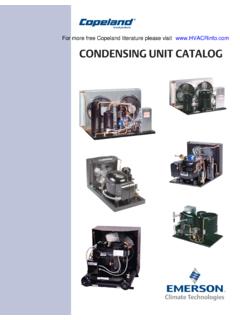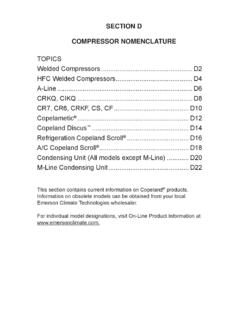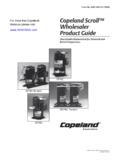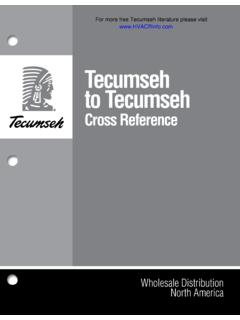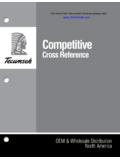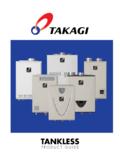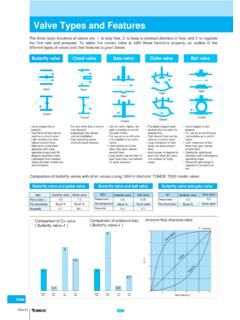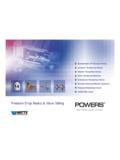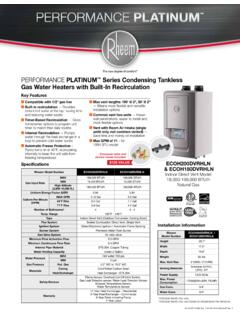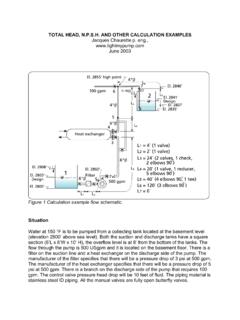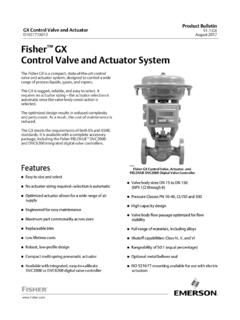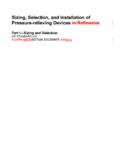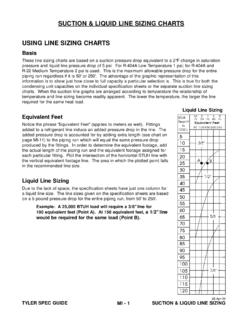Transcription of 3 COMPRESSOR MOTOR AND COMPONENT INFORMATION
1 A LOOK AT SERVICE SAFETY. 2. For more free Tecumseh literature please visit 3. COMPRESSOR MOTOR . AND COMPONENT . INFORMATION . I. Single Phase COMPRESSOR MOTOR Types . 16. II. PSC MOTOR Starting .. 18. III. Hermetic COMPRESSOR Thermal Protectors .. 19. IV. COMPRESSOR MOTOR Starting Relays .. 27. V. Selecting Capacitors .. 32. VI. Identification of Terminal Pins .. 34. VII. Fuse and Circuit Breaker Sizing .. 36. COMPRESSOR MOTOR and COMPONENT INFORMATION 15. I. Single Phase COMPRESSOR Alt. 3/4" Thermal Protector MOTOR Types Tecumseh hermetic compressors contain motors 4 T M Thermal Protector designed for specific requirements of starting torque Line 1 Control and running efficiency. There are four general types C. Start Winding of single phase motors, each distinctly different from Line 2. Main Winding Identified Conductor the others. Each type of MOTOR may have two to four (115 Volt Only - Neutral) S.
2 Different configurations depending on the compres- Ground sor components. COMPRESSOR - Unit Ground R. A. Resistance Start Induction Run (RSIR) PTC Relay This MOTOR , also known as a split-phase MOTOR , is Figure 3-2. RSIR MOTOR diagram with wired-in used on many small hermetic compressors up PTC relay. through 1/3 HP. The MOTOR has low starting torque and must be applied to completely self-equalizing capillary tube systems such as household refrigera- B. Capacitor Start Induction Run (CSIR). tors, freezers, small water coolers, and dehumidifi- The CSIR MOTOR is similar to RSIR except a start ers. This MOTOR has a high resistance start winding capacitor is included in series with start winding to which is not designed to remain in the circuit after produce a higher starting torque. This is commonly the MOTOR has come up to speed. A relay is necessary used on commercial refrigeration systems through to perform the function of disconnecting the start 3/4 HP.
3 Two types of relays are used with this winding as the MOTOR comes up to design speed. MOTOR : Three types of relays are used with this MOTOR : a current relay, or a current relay, a potential relay. a wired-in Positive Temperature Coefficient (PTC) relay, or External Thermal a module Positive Temperature Coefficient Control Protector Line 1 C. (PTC). Start Winding Main Winding External Thermal Protector Control C. Relay - Current Start Winding S. Main Winding Line 2. Line 1. Relay - Current R. S. Ground Line 2. COMPRESSOR - Unit R Ground Ground Figure 3-3. CSIR MOTOR diagram. COMPRESSOR - Unit Ground Figure 3-1. RSIR MOTOR diagram with current relay. 16 Chapter 3. A LOOK AT SERVICE SAFETY. C. Capacitor Start and Run (CSR) This MOTOR may use either: This MOTOR arrangement uses a start capacitor and a an external thermal protector, or run capacitor in parallel with each other and in series with the MOTOR start winding.
4 This MOTOR has an internal thermal protector. high starting torque, runs efficiently, and is used on PSC motors are basically air conditioning compres- many refrigeration and air conditioning applications sor motors and are very common up through 5 HP. through 5 HP. A potential relay removes the start External or Internal capacitor from the circuit after the MOTOR is up to Thermal Protector speed. This MOTOR may use either: Control Line 1 C. Start Winding Main Winding an external thermal protector, or Line 2. an internal thermal protector. S. Ground External or Internal COMPRESSOR - R. Thermal Protector Unit Ground Run Capacitor Control Line 1 C. Start Winding Line 2 Relay - Figure 3-5. PSC MOTOR diagram. Main Winding Potential Ground COMPRESSOR - Unit Ground S. R. Thermal Protector Line 1 C. Plug-In C. Start Winding Main Winding Figure 3-4. CSR MOTOR diagram. Run Capacitor C2 S. PTC.
5 C1 Relay D. Permanent Split Capacitor (PSC) Line 2. N R. Here a run capacitor is in series with the start wind- Ground PTC Starting and ing. Both run capacitor and start winding remain in COMPRESSOR - Protector Package the circuit during start and after MOTOR is up to Unit Ground speed. This normal starting torque MOTOR is suffi- cient for capillary and other self-equalizing systems. Figure 3-6. PSC MOTOR diagram with start assist kit No start capacitor or relay is necessary. For addi- that includes a module PTC relay. tional starting torque, a proper start assist kit may be added (see Figure 3-6). Some start assist kits may include: a wired-in Positive Temperature Coefficient (PTC) relay, or a module Positive Temperature Coefficient (PTC) relay. COMPRESSOR MOTOR and COMPONENT INFORMATION 17. II. PSC MOTOR Starting Minimum starting voltage for the COMPRESSOR Tecumseh Products Company has pioneered in when it is attempting to start (locked rotor) is: encouraging the development of Permanent Split Capacitor COMPRESSOR motors.
6 This type of MOTOR Table 3-7: Minimum Starting Voltage eliminates the need for potentially troublesome and costly extra electrical components (start capacitors Serial Label Voltage Min. Voltage for Start and potential MOTOR starting relays). (See Figure 115 103. Figure 3-7.). 208 188. 230 207. 230/208 198. External or Internal Thermal Protector 265 239. Control C. Line 1 Start Winding Main Winding Line 2 Unequalized system pressure : Head and suc- S tion pressures must be equal and not more than Ground 170 psig. Refrigeration metering device (cap COMPRESSOR - R tube or TX valve) should equalize system pres- Unit Ground sures within 3 minutes. Unequal system pres- Run Capacitor sure may be caused by excessive refrigerant Figure 3-7. Circuit diagram for PSC compressors. charge, short cycling thermostat, or system restriction. Circuit breaker or fuse trips: Branch circuit To fully realize the capabilities of this simplified type fuses or circuit breakers sized too small will of COMPRESSOR MOTOR , it is necessary to understand cause nuisance tripping (see Fuse and Circuit its starting and operating characteristics and the Breaker Sizing on page 36).
7 If the fuse or cir- field conditions which can affect it. cuit breaker trips, see Identifying COMPRESSOR Electrical Problems on page 47 for electrical The following conditions affect PSC MOTOR starting: troubleshooting techniques. Low voltage: Reduces MOTOR starting and run- Electrical components: A failed run capacitor ning torque. A 10% voltage drop reduces a will not allow the COMPRESSOR to start, and it MOTOR 's starting ability by 19%. Low voltage will trip the thermal protector. See Identifying can cause no start, hard start, light flicker, and COMPRESSOR Electrical Problems on page 47. TV screen flip flop. for electrical troubleshooting techniques. 18 Chapter 3. A LOOK AT SERVICE SAFETY. III. Hermetic COMPRESSOR Thermal Protectors Hermetic COMPRESSOR motors are protected from overheating by thermal protectors built into or mounted in contact with the COMPRESSOR MOTOR . See the Electrical Service Parts Guide Book for correct replacement thermal protectors.
8 Typical wiring dia- grams are shown on pages 51 to 82. The thermal protector device (see Figure 3-8), when firmly attached to the COMPRESSOR housing, quickly senses any unusual temperature rise or excess current draw. The bi-metal disc within the thermal protec- tor (see Figure 3-9) reacts to either excess tempera- ture and/or excess current draw by flexing downward, and disconnecting the COMPRESSOR from the power source. Figure 3-10. AE refrigeration COMPRESSOR showing (1) hermetic terminal, (2) thermal protector, (3) thermal protector clip, (4) push-on relay, (5) protective terminal cover, and (6) bale strap. Figure 3-8. External thermal protector. (Models AE, TP, TH, AK, AJ, CAJ, AZ, RK, RG, TW, and some CL.). Figure 3-11. AE refrigeration COMPRESSOR with the thermal protector and relay assembled. Open Closed Figure 3-9. Bi-metal disc. COMPRESSOR MOTOR and COMPONENT INFORMATION 19.
9 Table 3-2: Facts About Thermal Protectors Currently used on all AE, AK, AZ, RK, and AJ models Sense MOTOR current and housing temperature or combination thereof Break line current when tripped Generally do not protect against loss of charge External Line-Break Thermal When, by design, no air ow passes over housing, a special Protectors static thermal protector must be used Are designed for speci c compressors and their intended application. Make no substitutions Will not protect MOTOR if COMPRESSOR is operated outside its evaporator temperature range Currently used on all AH, AB, AV, AG, AW, and most AN and SF. models Sense MOTOR current and MOTOR winding temperature or combination thereof Internal Line-Break Thermal Break line current when tripped Protectors Generally protect against loss of charge Will not protect MOTOR if COMPRESSOR is operated outside its evaporator temperature range Not repairable or replaceable Currently used on some AN and SF models Employs use of solid state temperature sensors in MOTOR windings and COMPRESSOR discharge muf er Sensor resistance values change with temperature variations Module will interrupt power to the contactor coil when resistance Line Voltage-Electronic Protection values of sensors exceed the speci ed range.
10 This power Module interruption thus stops the COMPRESSOR MOTOR (NOTE: For more specific details Module provides protection against: consult the authorized wholesaler.) Abnormal locked rotor conditions Loss of refrigerant High COMPRESSOR discharge temperatures Excessive current conditions Time delays of 3 to 5 minutes occur on power interruption or sensor trip A. Internal Thermal Protectors Internal thermal protectors are completely internal 3-Phase MOTOR Thermal Protectors and tamper-proof. They cannot be by-passed. The 31HM and 32HM on-winding MOTOR protec- Single Phase MOTOR Thermal Protectors tors are 3-phase line break, automatic reset devices Internal thermal protectors detect excess heat and/or wired in series with each phase at the neutral point current draw. They are located in the following sin- and mounted on the windings. They are used in AB, gle phase motors: AB, AW, AH, AV, and AG.

